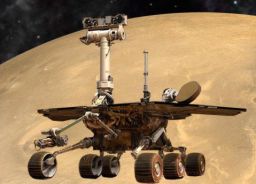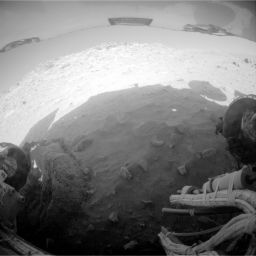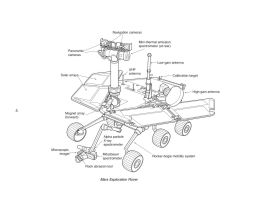A.J.S. Rayl • Mar 31, 2010
Mars Exploration Rovers Update: Spirit Begins Hibernation Probably, Opportunity Roves On to Endeavour Crater
March seems to have come in like a lamb and gone out like a lion on the Red Planet this year as the Mars Exploration Rovers trudged deeper into their fourth winter. While Opportunity finished up work at Concepción Crater and shifted into gear back on the road to Endeavour Crater, Spirit finished up winter preparations and carried out a limited winter agenda before shifting, it appears, into hibernation mode.
Spirit is parked, partially embedded, along the edge of the shallow sand-filled Scamander Crater, on the west side of Home Plate, a prominent, circular, old volcanic landmark in the Gusev Crater region. After being re-designated as a "stationary research platform" by NASA headquarters in late January, the rover did make a valiant effort to get out of the sand pit that snared her nearly one year ago. Although she did successfully move more than a foot, winter put a stop to that quest for freedom and at some point during the last week the rover seems to have gone into hibernation. From the looks of things now, this rover will be hunkered down, quietly 'snoozing,' at least until Martian spring.
As the outside temperatures began to fall toward -100 Celsius (-148 Fahrenheit) at Gusev Crater, Spirit’s power levels dropped, as expected, to some of the lowest levels recorded on the mission. With all non-essentials, including heaters, turned off, the temperature inside the rover electronics module (REM) – the center of the robot, which houses the warm electronics box (WEB) that encases the computer or "brains," as well as other crucial electronics that control movement and instrument deployment – also dropped to a record low of -41.5 Celsius (-42.7 Fahrenheit).
“It looks like we'll get to -55 Celsius (-67 F) [in the REM], which happens to be the coldest temperature or the qualification temperature for the rover electronics in a non-operating mode,” said John Callas, MER project manager, of the Jet Propulsion Laboratory (JPL) where the rovers were designed, built, and born. “The difference here, to use an analogy, is between a 19-year-old out at night in the middle of winter without a jacket and your grandmother being out at night in the middle of winter without a jacket.” Or, maybe your great grandmother. But, as Callas also noted: "It could be worse."
Spirit continued throughout the first three weeks of March to show her right robot stuff. After making some final adjustments to a specially created winter communication plan, the rover turned to conducting only the activities on her limited winter agenda: waking up each morning, checking the dust levels in the atmosphere, then shutting down to sleep until the next sol, and reporting in with mission control once a week. The rover spent rest of the time conserving energy.
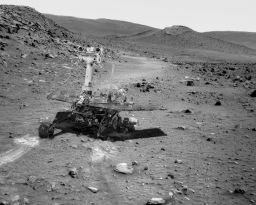 Simulation of Spirit's predicament
Simulation of Spirit's predicamentThis artistic image -- in which Astro0, of UnmannedSpaceflight.com, has placed a two-dimensional MER into a scene created by pictures taken by the real rover -- illustrates Spirit's predicament at the location in Gusev Crater known as Troy, before the rover moved 34 centimeters backwards in mid-February. Although "the angles are admittedly a little off and the disturbed soil isn't quite right," as he puts it, the image offers readers a glimpse into the present scene on Mars.
Credit: NASA / JPL-Caltech / ©Astro0 2009
The tip-off that Spirit has gone into hibernation mode comes when the downlinks – or the calls home – stop. "That will be our first indication that something is afoot," confirmed Callas.
Since Spirit failed to report in yesterday, on its Sol 2218 (March 30, 2010) as commanded, the immediate assumption is that the rover has entered hibernation mode – or, technically speaking, tripped the low-power fault.
“I thought the lights were going to go out a while ago,” said Steve Squyres, MER principal investigator, of Cornell University. But, at the same time, he noted, "these rovers have always overperformed."
Spirit has previously endured even lower temperatures than what she experienced this month, during the regional dust storm back in 2008 for example. “But this is the first time we've been this low for a sustained period of time,” Squyres pointed out.
Truths can be temporary in science and especially on an ever-evolving space mission like this, so the MER engineers are working to verify that hibernation – and not some telecom glitch or some other issue – is the cause for the rover's silence. But given all the data and knowledge thus far, it would seem the rover has drifted off for a nice, long winter's sleep.
"It's likely that Spirit has tripped the low-power fault that we expected, but we are doing our due diligence," Callas said late this afternoon. "We did review the telecom communication and everything was nominal. The margins were expected to have been healthy if there had been communication. We reviewed the sequence that was onboard Spirit to make sure there wasn't an error in the timing or the choice of communication and that review passed. There could be a different fault on the rover, like a hardware problem. We don’t know. But we were expecting the vehicle to trip the low-power fault and this is the behavior we expected, that she would go silent," he said.
Since the last time the team heard from Spirit was on March 22, Spirit could have tripped the low-power fault "days earlier than last night," Callas noted.
When the rover trips the low-power fault, it means that Spirit's batteries have been depleted below a specific cell voltage threshold. That threshold is breached when any cell in either battery drops below 2.9 V and the solar-powered rover shuts down and effectively takes a 'nap' until the Sun rises higher in the Martian sky and shines brightly down on its arrays.
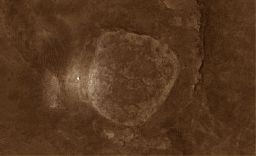 Spirit hibernating at Troy, we think
Spirit hibernating at Troy, we thinkIn this picture of Home Plate, taken by the HiRISE camera onboard the Mars Reconnaissance Orbiter, you can easily see the stark white figure that is Spirit to the left (west) of the geologic formation in this image enhanced by rover aficianado and UMSF.com's Stuart Atkinson. "It's just a screengrab from the excellent HiRISE IAS Viewer," he said. "I added some colour, then highlighted the position of Spirit. If you look carefully you can actually see bright trailing leading to Spirit - this is the result of the (right front) broken wheel being dragged through the dirt, unearthing brighter material beneath." For more of Stuart Atkinson's enhanced images, poems, and thoughts. particularly of the targets being investigated by Spirit's twin, Opportunity, check out his blog, "Road to Endeavour" at: http://roadtoendeavour.wordpress.com/Credit: NASA / JPL-Caltech / UA / enhancement by Stuart Atkinson
During this hibernation, the robot field geologist could be completely incommunicado for weeks or months, until the photons from the sunlight fuel can replenish the batteries come Martian spring or summer – although, as Callas mentioned in last month's MER Update, it is possible the rover will wake up periodically and phone home. “The batteries, however, will be heavily depleted and the rover will have to wait for them to charge way back up again before it will try to communicate," explained Callas. "But as the batteries charge up, a different set of survival heaters will come on that we can't turn off unless the rover is awake. Those heaters will then compete with the batteries for the available solar energy.”
Competition between the batteries and the survival heaters for energy may mean Spirit could be silent for "a long period of time," Callas said.
In the meantime, the MER team will be listening for those possible, intermittent calls home via the Deep Space Network (DSN), as well as through the UHF frequency linked through the Mars Odyssey orbiter. "We will be conducting a wait-and-listen campaign until we hear from her,” said Callas. "We may know nothing more than what we know right now for a period of time," he told the MER Update today. "We will listen to all of the potential fault windows on X band and UHF."
The team, actually, began listening for Spirit on Monday. "If we detect something, that will tell us a lot, and if we don't hear anything, then we really can't say anything more than we know right now, which is likely it tripped the low-power fault," Callas said. At this early stage of the probable hibernation, the rover may be silent for "months on the long end" or "a few days on the short end," he added. "That's why we need to listen at every opportunity going forward."
The silence won't exactly be viewed as golden. In fact, not hearing from Spirit for an extended period of time will be something new for team members and it may be difficult for some people, including those who have long been following the mission. “There are people who are stressed by this," Callas acknowledged. "People have a very strong affection for these rovers.”
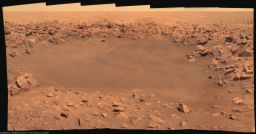 Concepción Crater
Concepción CraterOpportunity took the images that went into this picture of Concepción Crater with its Pancam last month (Feb. 2010). Using the raw imagery put onto the web at JPL and Exploratorium, James Canvin produced this picture in the living color you see here. "Notice the very faint hills on the horizon about 1/4 in from the right edge - that is Bopolu Crater more than 50 kilometers away!" he points out.For more of Canvin's MER work go to: http://www.nivnac.co.uk/mer/
Credit: NASA / JPL-Caltech / Cornell / rendered by James Canvin
At the same time, everyone seems to be keeping the faith that Spirit will pull through. “We designed the rover to be able to handle this kind of stuff," said the always-optimistic Squyres during a recent interview. "We all really expect it's going to be okay. We're all expecting her to come through the winter. I feel fine about Spirit myself."
On the other side of Mars, Opportunity finished work at Concepción Crater with an inspection of the rock debris in one of the rays emanating out from the young impact depression. Since the area was a little too rugged, and since the rocks appeared to be more of the same sulfate-rich sandstone chunks the rover has seen throughout the Meridiani Planum area since landing in 2004, the team opted to direct the rover to get back to making tracks.
Earlier this month, Opportunity hit the road, heading ever onward to Endeavour Crater, a gargantuan hole in the ground estimated to be about 22 kilometers (13.7 miles) in diameter, big enough to hold the borough of Manhattan, New York. Before it took off though, the rover 'smartened' up, successfully finishing the check-out of new software that was uploaded and stored in its non-volatile, flash memory back in December.
Called AEGIS – for Autonomous Exploration for Gathering Increased Science – the new software, which was nine years in development, was designed to give the rover the capability of making its own choices about whether to take additional pictures of rocks it spots on arrival at a new location. “It's a way to get some bonus science," explained JPL's Tara Estlin, a rover driver, senior member of the Lab’s Artificial Intelligence Group, and leader of development for this new software.
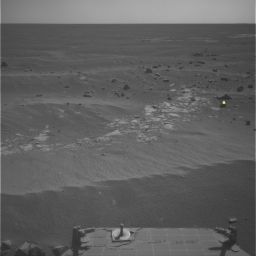 Opportunity tests AEGIS
Opportunity tests AEGISOpportunity took this image in preparation for the first autonomous selection of an observation target by a spacecraft on Mars. The rover used its navigation camera to take this picture after a drive on its Sol 2172 (Mar. 4, 2010). Using the newly developed and uploaded software named Autonomous Exploration for Gathering Increased Science, or AEGIS, the rover analyzed the image to identify the feature that best matched criteria given for selecting a target. The top target that Opportunity selected with AEGIS is shown by the yellow marker. AEGIS was directed to look for rocks that were larger and darker in color. The rover then used the software to take more detailed observations of the selected target using its Pancam. See below. Credit: NASA / JPL-Caltech
With AEGIS, Opportunity can now examine the pictures it takes with its wide-angle navigation camera after a drive, recognize rocks that meet specified criteria, such as rounded shape or light color. The rover can then center its narrower-angle panoramic camera (Pancam) on rocks or targets it chooses all by itself and take multiple images through color filters.
Both Spirit and Opportunity have received other software upgrades, or 'brain boosts,' since their first year on Mars. One upgrade, known as R92 software, enabled the twins to choose a route around obstacles and calculate how far they could extend their arms to touch a rock.
Then, in late 2006, the rovers gained new know-how so they could examine sets of sky images to determine which ones showed clouds or dust devils. With this new software, they could then transmit just the images with clouds or dust devils in them, thus saving a lot of time and effort for the team.
AEGIS takes that a step further, enabling Opportunity to make its own decisions about taking pictures of potentially science-rich targets. "We originally developed it thinking of MSL [Mars Science Laboratory] and also Mars Sample Return, because there wasn't time to get it on the original MER mission," said Estlin. "But MER opened the doors to uploading new technology, and when the R92 technologies went up we realized we should see if the rovers could use this too and so it worked out great."
The AEGIS team is slated to brief the MER science team today. "I'm really looking forward to using it operationally,” said Squyres.
At some point, it's "definitely a possibility" that Spirit would also get the AEGIS software. " It's the most useful when you're driving 40 meters or more or driving in terrain you haven't seen before and Spirit's drives are much shorter, so it's not as useful," Estlin said. "But it would still be very nice to run on that rover, even to just test it out for future mission use because Spirit is on very different Martian terrain."
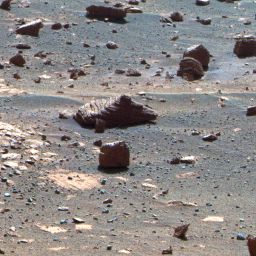 AEGIS rock
AEGIS rockThis picture is the result of Opportunity's autonomous selection of a rock to photograph, the first ever self-chosen target for imaging by a spacecraft on Mars. The rover used the newly developed AEGIS software to pick then target and then take this picture with its Pancam. This picture was taken earlier this month as part of a checkout of the AEGIS. Images taken through three of the filters are combined into this false-color view of the rock, which is about the size of a football. The false color makes some differences between materials easier to see. The rock in the target is close to a young crater called Concepción. It might have been thrown outward by the impact that excavated the crater.Credit: NASA / JPL-Caltech / Cornell University / USGS
With work at Concepción Crater done and its check-out of AEGIS complete, Opportunity returned to its prime directive – getting back on the road to Endeavour and it didn't take long before the rover established yet another record. “It's time to put down some mileage and that's what we've been doing,” said Squyres. "We cracked 20 kilometers this month!”
“Crossing 20 kilometers is really a big milestone," added Callas. "Who would have thought? The NASA requirement was 600 meters, .6 of a kilometer. Opportunity is really racking up the odometry."
During the last five sols, Opportunity cruised by a pair of craters – which the team nicknamed San Antonio West and San Antonio East – and conducted some "drive-by shootings," or, in other words, took a few pictures with its cameras. Then, reported JPL's Matt Golombek, an MER science team member, the rover got back on track to Endeavour.
Since Opportunity is closer to the equator than Spirit, it will probably not have to stop at all for winter. In fact, the plan is that this rover will keep on ‘truckin’ while its twin sister hibernates. It does have less energy in the winter though and so the drives will likely get shorter, said Callas, or the rover will drive more infrequently to allow more recharging between drives. But at this point, Opportunity is producing enough power to keep knocking off solid 50-to-60-meter drives every drive sol and so far all its wheels are rolling along just fine.
That's good news because Endeavour is still an estimated 12 kilometers (7.45 miles) away by the route chosen. And because it means Opportunity will have the chance to set more records in coming weeks and months. “We're looking forward to crossing a half-marathon pretty soon," Callas pointed out. "That will be 21.1 kilometers."
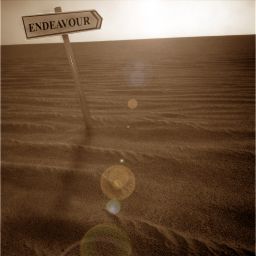 Onward
OnwardOpportunity put the pedal to the metal this month and left Victoria Crater, its home for the past 2 years, for good. It's been making regular 100+-meter drives and last weekend nearly broke its own record when it logged a 216-meter drive. This image, which the rover took with its Pancam was enhanced with humor by Stuart Atkinson, a space enthusiast from the United Kingdom. Credit: NASA / JPL / Cornell / Stuart Atkinson
Neither Spirit or Opportunity suffered any new failures or sustained any new injuries this month. Despite the falling mercury, both rovers, now well into in their seventh year of exploring the Red Planet, remain in overall good health as they plod determinedly, if only metaphorically in the case of Spirit, toward the Martian winter solstice in May.
In other MER news, the International Committee on Technical Interchange for Space Mission Operations, also known as the SpaceOps Organization, announced this month that it had chosen the rovers' handlers for the 2010 International Space Ops Award for Outstanding Achievement. The team that operates the rovers is being cited "for remarkable success in meeting unique and varied challenges of operating a rover on Mars and establishing a model for future in-situ operations."
The organization created the award to recognize "teams whose exceptional contributions were critical to the success of one or more space missions." A panel composed of members from several nations' space agencies selects the recipient for the Space Ops Award for Outstanding Achievement, which is presented only once every two years.
It's a nice new trophy for the case, especially since there have been only two prior recipients: the Landsat 5 Flight Operations Anomaly Team in 2006, and the Ulysses Mission Flight Team in 2008. The citation for this year’s award is to be presented to the MER operations team next month in Huntsville, Alabama.
Spirit from Gusev Crater
As February gave way to March, Spirit was producing about 153 watt-hours of power, under slightly hazy skies, measuring an atmospheric opacity or tau of around 0.33, fairly typical for winter in Gusev. The rover's dust factor was about 0.51, meaning half the sunlight fuel she was taking in was being converted to energy.
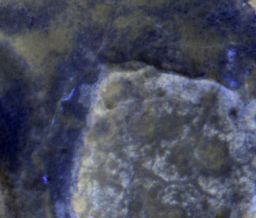 Spirit at Home Plate
Spirit at Home PlateThe HiRISE camera onboard the Mars Reconnaissance Orbiter took this look at Spirit's parking spot at Home Plate on July 16, 2009. Spirit is at lower left, the west side of Home Plate, the circular volcanic formation the rover spent more than two Earth years roving on, over, and around.Credit: NASA / JPL / UA
The first order of business for Spirit in March was to finish preparations for winter and its forthcoming hibernation phase. The rover had already sent down most all the data that had been lingering in its flash memory and pretty cleared the slates, so to speak. “We got almost everything down,” reported Squyres. “I think there might have been a few really ancient dust devil movies, but basically we got everything cleared out. What's left will still be there after winter.”
During the first week of March, Spirit successfully completed its last preparatory task, finalizing settings on its new long-range UHF communication table, so it would know when to phone home, if possible, during hibernation and when to check in once winter passes. Then, the rover settled into the reduced winter operations schedule, which it would carry out for as long as possible before taking a long snooze through the rest of the season.
Basically, Spirit's ops consisted of a 7-sol plan each week, sent up in a single communiqué via the X-band radio link, and a single ultra-high frequency (UHF) downlink report. The workload for each sol is simple: wakeup, check out the level of dust in the atmosphere by taking a tau measurement, and then shutdown for the rest of the day and night. The rover completed the first week of the month as commanded, phoning home with a downlink on Sol 2195 (March 7, 2010).
In that downlink, Spirit informed the team that her energy production of 151 watt-hours was matching her energy consumption. Team members expected this to diverge, of course, when the rover's energy decreased even more as the Sun descended lower in the sky, and as energy demands from heaters increased with the fall of environmental temperatures.
As March marched on, Spirit continued to get colder and colder, but the rover kept to its routine throughout the second week of the month. After executing the single, 7-sol plan, the rover checked in on schedule on Sol 2203 (March 15, 2010), revealing she was still under master sequence control and that all systems were “green,” even though her energy production had dropped to 139 watt-hours per sol.
“We've been building the plans on Friday and they get uplinked within the next half-day or so,” said Callas. “We're doing a 7-day plan with the uplink on the first day and the downlink just a day or two later. The logic here is that if the rover is going to go into a low-power fault, it's likely to go into it at the end of the week rather than the beginning," he elaborated. "To say that another way, we have the highest probability of getting the downlink as soon as we can schedule that to occur, because the power levels are only decreasing with time. So, we're trying to do everything in the early part of the schedule.”
The rover planners (RPs), however, did notice a change in the behavior of the battery survival heaters. The implications of this change are "not yet known," said Callas, but the engineers are continuing to investigate. “What we normally see when we get the telemetry from the rover is the heaters cycling on and off. What we've noticed is that cycling on and off has shrunk to a tiny deadband – the term they use for bouncing back and forth is deadband. In other words, that cycling has decreased, and we don't know what that means yet," he expounded.
The engineers do have hypotheses about what might be happening, but Callas declined to speculate at this point. "We just noticed that it's a change," he said. "Spirit is going into a new regime. The rover is getting colder and we're noting any and all behavioral changes.”
Interestingly, according to the data in that downlink, the state of charge of Spirit's two main power batteries had not decreased significantly, suggesting that the rover was able to stay roughly power neutral during the later part of that week. Even so, her power production levels, the team knew, would continue to drop and heating requirements would continue to increase, and soon lead to widening energy deficits.
The MER team is using the solid-state power amplifier (SSPA) inside the rover electronics module (REM) as a proxy for the temperatures that Spirit's computer and electronics are experiencing. The REM is a rack of electronics inside the insulated WEB of the vehicle, Callas said. Just as our brains are protected by our skulls and our hearts by layers of muscle and rib cages, the rover's "organs" are protected in the WEB. The gold-painted walls of the protective, insulated box help keep the vital components warm when nighttime temperatures dip to a beyond brutal -110 degrees Celsius (-148 degrees Fahrenheit). A layer of aerogel, a unique, extremely powerful and lightweight material known as "solid smoke" serves as additional insulation inside the box.
"The SSPA is one component that is part of that collection of electronics and that's the temperature we're reading, using it as an indicator of how everything is doing inside the REM," Callas explained. "It's kind of like if you have a group of people in a room and you ask one: 'Are you warm or cold right now?' That person would be the proxy for how the entire group is feeling. In Spirit’s case the SSPA is the proxy," he explained.
The temperature can vary from one component to the other; therefore, it is possible some instruments are colder or warmer than the SSPA. “But the SSPA tends to be colder than some of the other components so we think," said Callas. "But there's only a small difference of a degree or so between components, so it is our best guess of what the temperatures are inside the rover electronics box.”
According to the SSPA, the REM in mid-March reached a new record low temperature of -41 degrees Celsius (-41.8 degrees Fahrenheit), indicating that the rover electronics were getting colder than ever before. Still, the little-rover-that-could was hanging in there, so the team sequenced another 7-sol plan and uplink it on March 19, 2010.
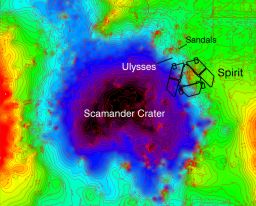 Topographic map of Spirit's location at Troy
Topographic map of Spirit's location at TroyThis topographic map of Spirit's location at Troy represents low elevations in black, purple, and blue and high elevations in red. It was developed based upon Spirit's camera images of the location, taken before it got mired at Troy. The topographic model has had a regional slope removed, which reveals that Spirit's left wheels are sitting inside a subtle depression that is right on the edge of a crater that the team has named Scamander Crater. The right-side wheels are outside the depression.Credit: NASA / JPL-Caltech / Ohio State University
True to the MERs' proven resilience, Spirit carried on with her winter ops and downlinked her report as directed on Sol 2210 (March 22, 2010). Indeed, the RPs saw that their robot field geologist was still under master sequence control. Moreover, they were delighted to see that all the rover's systems were still green, despite the fact that power levels had dropped down to 133 watt-hours per sol. “I really did think the lights would go out about 20 watt-hours ago. We're all pretty surprised that the rover is still talking to us," Squyres said then.
Spirit also informed her team that the SSPA reached another new low of -41.5 degrees Celsius (-42.7 degrees Fahrenheit). Current projections, Callas said, indicate that the rover's REM will drop to -55 C (-67 F). Those who have been following this mission from the beginning know, -55 C happens to be the qualification temperature for the rover electronics in a non-operating mode. Given that, it would seem that the worst to come won't be so bad, at least at first blush. “When we tested the rover electronics to that -55 C low," he reminded, "that was a brand new rover right out of the box.”
Time will tell. Just for the record, Spirit's power previously dropped well below 133 watt-hours. Back in November 2008, when the rover was suffering the havoc wreaked by a regional dust storm, it witnessed a spike in atmospheric opacity to a tau of 2.3 and its power levels plummeted to 89 watt-hours, beating Opportunity's record low of 127 watt-hours during the global dust storm of 2007 and establishing a new low power record. Actually, Spirit’s power was so dramatically low it caught the team by surprise, according to Sharon Laubach, the integrated sequencing team chief. There was “no way” the rover could sustain itself for long generating that extreme low amount of power.
“That was not a long-term thing,” Squyres pointed out. Indeed, within days of reaching that all-time low, however, Spirit's power rose and it roved on without ever draining its main batteries. “While there have been a couple of brief excursions with extreme low power levels during dust storms, this is the first time either rover has experienced these record low levels for a long period of time.”
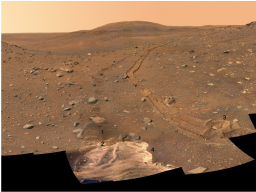 Spirit's Calypso annotated
Spirit's Calypso annotatedThe tracks tell the story of Spirit 's entrapment. When the rover got stuck, it was driving backwards, dragging the right front wheel behind it. At first, it left tracks in the firm soil on the left side of this view while the dragging wheel created a shallow trench on the right side. At Point 1 in the annotated image at right, the soil began to get looser. At Point 2, the left-side wheels broke through the firmer surface crust, exposing softer, brighter (and, it turns out, sulfate-rich) soil underneath. At Point 3, right-side progress slowed as the other five wheels began to dig down. The frozen right front wheel did not break through and began to act as a pivot, causing the whole rover to veer to one side. At Point 4, we see the steep walls of the left-side trench Spirit dug as it sank into the sand. The shape of the wall was carved partly by the left-side wheels as Spirit steered and attempted to turn back on course. Credit: NASA / JPL / Cornell / color mosaic by James Canvin
Both Spirit and Opportunity have repeatedly shown their pluck during the last six-plus Earth years, proving their worth a thousand times over. There is something, though, that explains at least a little of the magic that seems to have accompanied these rovers since the beginning, a secret of sorts that no doubt has helped their ability to live long and prosper.
“No engineer wants to be the person who designed the system, the sub-system, or the part that causes the mission to fail or even that would cause the rover to go into some fault mode, so everybody who worked on these rovers just tucked a little bit of extra margin into their design," Squyres revealed. "That margin all adds up and it adds up in better-than-anticipated performance and we've seen it again and again on this mission. I'm trying to remember the last time these rovers didn't perform up to spec – and I don't know if that's ever happened. They always outperform.”
Actually the rovers have outperformed so many times and for so long that it's hard for many people who have been working on or following the mission, all of whom have developed deep emotions for these 'bots, to believe the sols will ever come when Spirit and Opportunity stop performing. Still, there is no argument that this fourth Martian winter will be Spirit's most challenging and a lot of folks were just holding their breath this month waiting for the sign that the rover had tripped the fault.
When the downlinks stop coming, the team will know Spirit's hibernation phase has likely begun. “Of course, we won't know for sure," said Callas. "But that’s when we will start our listening campaign through the Deep Space Network (DSN). The low-power fault will use the X band communication window through the DSN, so we will listen there first. Then, after about a week, a second fault will occur with the Uploss timer. This a timer we set every time we command the rover and when that timer expires, it's an indicator to the rover that there may be a problem," he explained.
Generally, the Uploss timer is the mechanism a spacecraft uses if it goes "tone-deaf" or can't hear anything from its mission control. In essence, the device allows the spacecraft to figure out whether the problem is with itself or with the ground not talking to it. "The timer is designed so that if a certain amount of time elapses, then the spacecraft takes action," Callas said. "In the case of the rover, once it assumes it's gone tone-deaf on X band, it will start to try and communicate through UHF via Mars Odyssey. That’s when we will begin to listen with the orbiter, because even though there is a low-power fault, the Uploss fault takes precedence."
Therefore, after slipping into hibernation mode, Spirit – once its batteries recharge to the point of being able to communicate – will attempt to phone home via two paths: X band directly to Earth to the DSN or through UHF via Mars Odyssey.
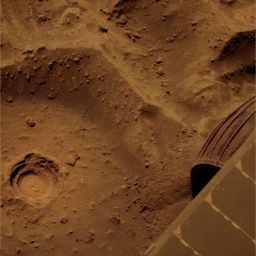 A good omen?
A good omen?This image, which Spirit took with its Pancam last month, features a discreet sign of luck that just may be a good omen of things to come for this devoted and determined rover. Enlarge the image, then look inside the circular depression. As rover aficiando Stuart Atkinson,who discovered this, put it: "That has to be a lucky horseshoe in that hole." Actually the rover created the circular depression with its rock abrasion tool (RAT); nevertheless, the horseshoe certainly wasn't planned. It would seem to indicate this rover is ready to rove again, but the fact that the horseshoe is positioned sideways will keep us guessing until the Martian spring, or maybe summer. Credit: NASA / JPL-Caltech / Cornell / colorization by Stuart Atkinson
The team had Spirit pre-set windows for each sol during which it will attempt to communicate with Earth and team members will be listening for the now iconic beeps from the start, even though the rover probably won’t be sending any for some time after shutting its systems down. In all probability, the team will at first find themselves listening to long bouts of silence. "It's likely that when Spirit trips the low-power fault that it will take some time, weeks, before the batteries can charge back up enough for the rover to talk with us, but we will likely start listening right away, because we don't know how this vehicle will behave in this state that it's never been in before,” elaborated Callas.
Once Spirit fully shifts into hibernation mode, the batteries will immediately try to charge back up, but before long a set of survival heaters will automatically turn on and the RPs will not be able to turn them off unless the rover is awake. Those heaters will compete with the battery for the available solar energy. So the rover batteries will be in something of a battle for power, at least for a while. “The batteries will charge to a point and then they will run into competition with this set of heaters,” Callas confirmed. “From that point, the charging-up will be much slower. That's what will draw the process out. It could be weeks, more than a month.”
There's also the risk of a master clock fault, as Callas explained in last month's MER Update. The master clock is how Spirit knows what time it is. Considering there's a drift in virtually all time mechanisms, whether it's your watch or her clock, and that a Martian sol is a little more than 39 minutes longer than an Earth day, keeping the clocking ticking and on time is important. And this month, Callas said, the likelihood of the rover tripping the master clock fault has increased "a little bit."
The initial predictions were that Spirit would make it through winter without the master clock going into a fault, the power estimates for the rover turn out to be lower than what was originally estimated, said Callas. While indications continue to predict the master clock will not fault, he qualified, there is some uncertainty. And, as the MER saying goes, this is Mars.
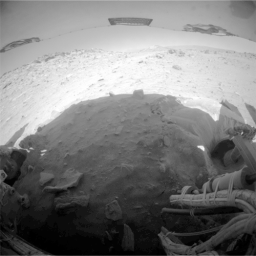 Taking it backwards
Taking it backwardsThis two-frame animation, is created from two wide-angle pictures that Spirit took this January shown one after the other. The rover took the images with its rear hazard-avoidance camera: one at the end of the previous drive two sols earlier and then after the Sol 2147 (Jan. 16, 2010) drive. Visible changes from the first to the second, as a result of the rover's motion, include the landscape appearing to shift to the right and the forground rocks near the bottom of the image appearing to come closer. The view is to the south, looking at and beyond Spirit's rear wheels, with the bottom surface of a solar panel at the top of the image. During this drive, Spirit moved about 3.5 centimeters (1.4 inches) southward and yawed slightly counterclockwise. Neither the right-rear wheel (at the left in this view) nor the right-front wheel can contribute to driving.
Credit: NASA / JPL-Caltech
If the master clock does fault, Spirit will likely not be able to generate enough power to wake up until the Martian summer arrives, meaning the rover could snooze for months, effectively turning into Sleeping Beauty, as Callas explained in the MER Update last month. “She would have to wait for Prince Charming," he reiterated this month. "That would be when the Sun comes back with sufficient power to charge up the solar arrays. That's called a solar array wake-up event, and it requires the solar arrays to generate more than two amps of current.”
An Earth analogy of that scenario, as Callas has said before, is this: your power goes out and your alarm clock doesn’t go off, but when the Sun comes streaming through your windows andfalls on your face, you wake up. Until the rover can generate more than two amperes of power, however, it would be more like the Sun trying to penetrate really dirty, dusty windows. “Even if the Sun comes up, there’s not quite enough sunlight getting through to wake you up," he said.
On Mars though, spring will bring the winds and gusts that could help the rover out by clearing some of the accumulated dust from its solar panels, boosting energy and brightening the outlook for an earlier awakening.
Activities that demand power, such as a telecommunications session or a heating session, are the "higher probability events" that will cause the rover to shift into hibernation, noted Callas. “So the rover is likely to trip the low-power fault when we uplink the plan, when we downlink, the plan or when heaters come on for various rover components which is usually very early in the morning.”
Now, at the end of the month, it looks like Spirit probably has finally tripped the low-power fault and perhaps it did happen when the rover attempted to phone home, as it had been commanded to do yesterday. Or, perhaps, it happened last week. Although the rover planners uplinked the 7-sol plan last Friday, they don't know for sure if the commands got onboard. All that is known as the MER Update goes to "press," is that the rover didn't check in when it was supposed to and no data came back to JPL last night. Of course, it could be some telecommunications glitch or even a hardware problem, but it doesn't really seem likely. With the intel they have, it would seem Ockham's Razor in in force – all other things being equal, the simplest solution tends to be the best – and that is the rover has transitioned into hibernation.
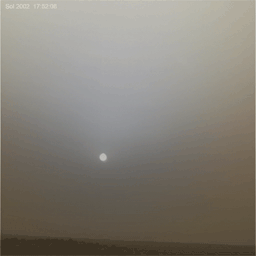 A dusty sunset on Mars
A dusty sunset on MarsWhile bogged down at Troy, Spirit looked westward on the evening of sol 2,002 to watch the Sun set. Before it reached the horizon, the Sun vanished into dust kicked up in a regional dust storm. This animation is composed of 11 Pancam frames captured over 12 minutes; they have been artificially colorized to add drama. Credit: NASA / JPL / Cornell / animation and colorization by Peter Greutmann
There’s no question, however, that Spirit is facing great uncertainty this winter. “There are risks that the vehicle is facing,” Callas underscored, “and people do need to realize that she will likely be silent for a long period of time.”
The current predictions and the tenor of the team remain much the same as they did in February. Engineers are expecting the master clock will not fault and most team members are keeping hope alive that their rover will survive its fourth Martian winter and rove on, and for all good reasons. Still, no matter how you look at it, not being able to hear from Spirit is going to be a big adjustment.
From all outward appearances, the team is prepared for the sounds of silence to come. “But it's hard to say,” said Callas. “I suspect everyone has put on a brave face. It's just like a beloved pet or a dearly beloved relative who is sick in the hospital and you don't know why and you don't know if they’re going to get worse, or get better. That uncertainty is often more stressful than the reality.”
“I think we're okay,” Squyres offered. “The rover is going to do what it's supposed to do. Maybe she won't make it through winter, but we all think it's pretty darn likely that she will. And everybody on the team is looking forward to starting normal operations again come springtime. My sense of it is, the mood is very upbeat. We're just going into a hiatus here.”
After six-plus Earth years, a hiatus will give team members working since the beginning a bit of a break. “It's a chance maybe to catch up on some other things,” said Squyres. At the same time, everyone is hoping Spirit’s sounds of silence don’t last too long.
 Calypso Panorama
Calypso PanoramaSpirit took the images for this full-circle view with it panoramic camera (Pancam). It shows the terrain surrounding the location called Troy, where Spirit became embedded in soft soil, called Ulysses, in May 2009. The rover began taking the hundreds of images combined into this picture beginning on its Sol 1906 (May 14, 2009), finishing on Sol 1943 (June 20, 2009). North is at the center; south at both ends. The western edge of the low plateau called Home Plate dominates the right half of the panorama. At the far right is a bright-topped mound called Von Braun, the once-planned next stop for Spirit. Near the center of the panorama, in the distance, lies Husband Hill, where the rover recorded views from the summit in 2005. The ridge on the left, near the rover tracks leading to Troy from the north, is called Tsiolkovsky. For scale, the parallel tracks are about 1 meter (39 inches) apart. The bright soil in the center foreground is Ulysses, the patch in which Spirit remains embedded. The composition of different layers in the soil at the site have become the subject of intense investigation.Credit: NASA / JPL / Cornell University
Opportunity from Meridiani Planum
With power levels of around 278 watt-hours Opportunity roved into March under moderately hazy skies and embarked on the final phase of its checkout of Concepción Crater. The rover had been studying the young crater throughout February and plans called for it to wrap its investigation with a drive around a prominent ray of rock debris emanating from the young, 10-meter (33 foot) diameter depression.
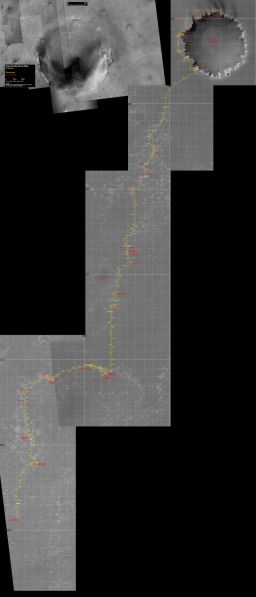 Opportunity route map
Opportunity route mapThis route map, which was put together by MER aficianado Eduardo Tesheiner, a senior member of UnmannedSpaceflight.com, is comprised of images taken by the HiRISE camera and CTX cameras onboard the Mars Reconnaissance Orbiter and shows Opportunity's route from Victoria Crater up to it most recent drive-by shootings at a pair of "twin" craters called San Antonio East and San Antonio West.Credit: NASA / JPL-Caltech / Cornell / UA / MSSS / created by Eduardo Tesheiner
In High Resolution Imaging Science Experiment, aka HiRISE, images taken from the Mars Reconnaissance Orbiter, the ray appeared as one of several dark streaks extending to the south and southwest from Concepción, as Scott Lever, an MER mission manager, mentioned in last month's MER Update. These dark streaks are, actually, what lured the scientists and Opportunity to the site, because they seemed to suggest the crater is young. The scientists were not disappointed, though they were kind of tricked.
"We wondered before getting to Concepción why the rays are dark," said JPL’s Matt Golombek, an MER science team member. When Opportunity did arrive, the scientists discovered that the rays are areas with blocks of light-toned sandstone ejected from the crater. “They look dark from orbit because of the shadows that the blocks are casting when the orbital images are taken in mid-afternoon,” Golombek explained.
MER scientists had chosen potential targets within this particular dark ray for Opportunity to check out up close with its instrument deployment device (IDD) or robotic arm with data collected late last month, on Sols 2165-2166 (February 25-26, 2010). But when they realized that the mobility risks in the jumbled rock field outweighed the benefits, they cancelled the in situ studies.
Simply put, Opportunity has seen many, many similar soft, sulfate-rich sandstone rocks featuring the iron-rich, peppercorn-size, dark spherules, dubbed "blueberries,” at literally hundreds of locations since landing in January 2004. It just wouldn’t be worth taking a chance on getting stuck or damaging the rover. Instead, Opportunity headed around the ejecta ray on Sol 2171 (March 3, 2010) with an 18-meter (59-foot) drive to wind up its Concepción circumnavigation campaign.
During this last leg around the crater, on Sol 2172 (March 4, 2010), Opportunity conducted the final checkout of its new AEGIS automated targeting software, according to Tara Estlin, the software lead. In this task, the rover used its new “smarts” to analyze a navigation camera (NavCam) image and search for cobbles using a profile that prioritized rocks based on rock size and brightness. It then made a selection out of more than 50 possible targets in the navigation camera photo, deciding one in particular best met the criteria the researchers had set for a target of interest: large and dark. Then, Opportunity autonomously pointed its Pancam and snapped a high quality, quarter-frame, 13-filter picture of the rock with no name. The rover did good.
 Opportunity's first self-chosen rock
Opportunity's first self-chosen rockThis is the first picture of a rock target selected autonomously by a spacecraft on Mars, and another achievement by the MER mission. Opportunity took this picture on its Sol 2172 (Mar. 4, 2010) as part of a checkout of its new AEGIS software that enables it to autonomously choose a target from a wider-angle image and then use its Pancam to snap a the image through the camera's 13 different filters. Rock on Opportunity.
Credit: NASA / JPL-Caltech / Cornell
As it turns out, Opportunity chose a cobble about the size of a football that is tan in color, and layered in texture. Moreover, the rock appears to be one that was tossed outward onto the surface when an impact dug a nearby crater. "It found exactly the target we would want it to find," Estlin said. "This checkout went just as we had planned, thanks to many people's work, but it's still amazing to see Opportunity performing a new autonomous activity after more than six years on Mars."
Beyond the success of the software checkout, Opportunity’s work represents the first photographs taken by a Mars rover choosing its own target, another first for this rover and the MER mission.
Before AEGIS, Opportunity would only conduct follow-up observations after first transmitting the post-drive navigation camera images to Earth where MER team members could peruse them and choose targets of interest for the rover to examine on a later day. Time and data-volume constraints, however, had often forced the team to drive again before potential targets could be identified or before examining targets that weren't highest priority. Now, Opportunity can use AEGIS at stop points along a single sol's drive, or at the end of the drive, to identify and examine targets of interest that might otherwise be missed, Estlin pointed out.
Better still, scientists can change the criteria used for choosing potential targets, she added. In some environments, rocks that are dark and angular could be higher-priority targets than rocks that are light and rounded, for example.
"We spent years developing this capability on research rovers in the Mars Yard here at JPL," noted Estlin. "Six years ago, we never expected that we would get a chance to use it on Opportunity."
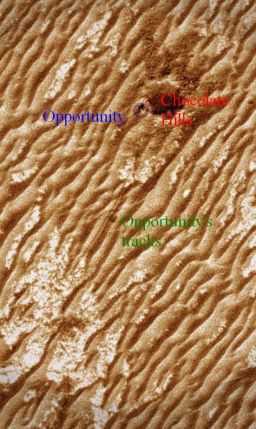 Opportunity seen from orbit
Opportunity seen from orbitNASA released an image of Opportuntiy at Chocolate Hills rock this month that was taken by the University of Arizona's Hi-RISE (High Resolution Imaging Science Experiment) camera onboard the Mars Reconnaissance Orbiter. The image here was colorized and labeled by Stuart Atkinson, who is documenting the rover's journey to Endeavour Crater at his Road to Endeavour blog: http://roadtoendeavour.wordpress.com.Credit: NASA / JPL-Caltech / Cornell / UA / colorization by Stuart Atkinson
AEGIS could and will be used with other instruments on future missions. And if an opportune gust of wind should come along and clear the dust from the mirrors of Opportunity's Mini-TES mirrors, "that would be a great application for AEGIS," Estlin said.
“This new software is really neat,” said Squyres. “So far, it’s just been testing and checkout. We’ll be learning more about it in the briefing from the AEGIS team [today], but I think it's time to actually start doing some science with it and see what we get.”
In the meantime, the MER science team released its findings from preliminary analysis of the data Opportunity sent home on its research at Chocolate Hills, the rock at Concepción that the rover spent a considerable amount of time studying.
"It was clear from the images that Opportunity took on the approach to Concepción that there was strange stuff on lots of the rocks near the crater," recounted Squyres. "There's dark, grayish material coating faces of the rocks and filling fractures in them. At least part of it is composed of blueberries jammed together as close as you could pack them. We've never seen anything like this before and we were pretty psyched about it. To have been driving around on these Meridiani rocks for so long and to have never seen anything like this, to have something that strange and that different come up was really kind of a surprise,” he said. “I thought it was extremely cool.”
In some places, the layer of closely packed spheres on Chocolate Hills Rock lies between thinner, smoother layers. "It looks like a blueberry sandwich," described Golombek.
With almost every instrument in its science arsenal, Opportunity examined this unusual material on Chocolate Hills, so-named because the strange stuff appeared dark and because the patch in which it sat looked dark from orbital images.
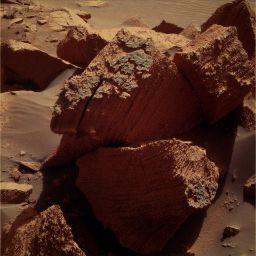 Chocolate Hills
Chocolate HillsOpportunity took this image of the Chocolate Hills rock that it studied up-close this month (February 2010) with its panoramic camera. It was enhanced by MER poet-artist Stuart Atkinson, whose work has been appearing in these Updates frequently.Credit: NASA / JPL-Caltech / Cornell / enhanced by Stuart Atkinson
Initial analysis of the composition of the patchy coating does not show any obvious component from whatever space rock hit Mars to dig the crater, but that’s not really surprising, Golombek said. "The impact is so fast, most of the impactor vaporizes. Thin films of melt get thrown out, but typically the composition of the melt is the stuff that the impactor hit, rather than the impactor material,” he explained.
At this point, the stuff remains something of a Martian mystery. “We've been driving around this part of Mars for six years and never seen this stuff before, then we get to this young crater and it's coating rocks all around the crater,” said Golombek. “Sure looks like there's a connection, but it could just be a coincidence."
The composition of the dark coating material fits at least two hypotheses being evaluated, and possibly others, according to Golombek. One is that the material resulted from partial melting of blueberry-containing sandstone from the energy of the impact. Another is that it formed from filling of fractures in this type of rock before the impact occurred.
"Different people have their own preferences and we're trying to work through it,” Squyres told the MER Update. “It's possible that when you melt this rock, the sandstone melts before the blueberries do, leaving intact blueberries as part of a melt layer. As an alternative, we know that this type of rock has fractures and that the sandstone can dissolve. Long ago, water flowing through fractures could have dissolved the sandstone and liberated blueberries that fell down into the fracture and packed together. In this hypothesis, the impact that excavated the crater did not play a role in forming this material, but split rocks along fractures so the material is exposed on the exterior like a coating,” he explained.
The debate will probably be resolved in the not too distant future. “Some good sound geochemical modeling will probably lead us to the right answer,” offered Squyres, “but right now we're in the multiple working hypotheses phase of things.”
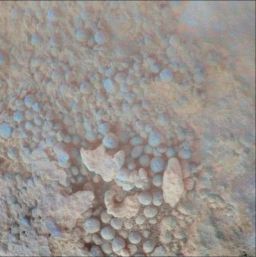 Chocolate Hills up-close and personal
Chocolate Hills up-close and personalOpportunity took this close-up picture of the target Aloya on Chocolate Hills with its microscopic imager (MI) on its Sol 2150 (Feb. 9, 2010). The view here covers an area about 3 centimeters (1.2 inches) across. The color comes from imaging the same area with the Pancam and is false color to highlight differences in materials. The target Aloya was chosen because it is part of the strange, intriguing coating that covers Chocolate Hills. The coating includes a layer in which peppercorn-size spherules long ago dubbed "blueberries" are packed densely. "We have never seen anything like this before," MER Principal Investigator Steve Squyres told the Update. Credit: NASA / JPL-Caltech / Cornell
The observation that the rocks thrown from the crater are not all that eroded is evidence that the crater is young, confirming the theory the scientists deduced from the dark rays in the orbital images. "We're not ready to attach a number to it, but this is really young,” Squyres said. “It is the youngest crater we've ever seen with Opportunity and probably the youngest either rover has seen."
On Sol 2177 (March 9, 2010), after six weeks of study, Opportunity left Concepción to journey on, its eyes on the “prize” of Endeavour Crater. “It takes a compelling target for us to stop and study, and Concepción was a compelling target,” said Squyres. “Now we’re on the road again.”
Opportunity put the pedal to the metal and began making impressive progress as it drove backwards along its own sort of Route 66 to its next major destination.
Backwards driving, as those following the mission know well, is one of the techniques the rover has been employing to keep its right front wheel running cool, or, more specifically to keep its actuator from drawing more current than the other five wheels, an issue that has occurred from time to time since last year especially during the rover’s long drives. “We have a healthy rover and we have enough power for substantial drives,” noted Squyres. “We want to keep it that way.”
On Sol 2179 (March 11, 2010), Opportunity jogged slightly to the southwest, putting more than 70 meters (230 feet) of distance on its odometer. Two sols later, it cruised in a more southerly direction, covering nearly 73 meters (240 feet). Then, the rover made two more drives due south on Sols 2183 (March 15, 2010) and 2184 (March 16, 2010), achieving 71 meters (233 feet) each. In just those four jaunts, the rover logged a total of almost 285 meters (935 feet) of progress, pushing its odometer to 19,778.24 meters (12.29 miles). Pretty impressive for a winter’s trek.
The rover continued to drive throughout the third week of March and into the fourth. On Sol 2186 (March 18, 2010), it drove backwards again, heading to the southwest this time for about 64 meters (210 feet). The rover then headed south again on Sol 2188 (March 20, 2010), covering nearly 71 meters (233 feet) and took another drive due south on Sol 2190 (March 22, 2010), putting another 63 meters (207 feet) on its odometer. Then, with a 67-meter (207-foot) drive on Sol 2191 (March 24, 2010), Opportunity achieved yet another major milestone -- it passed the 20-kilometer mark. That’s 12.43 miles.
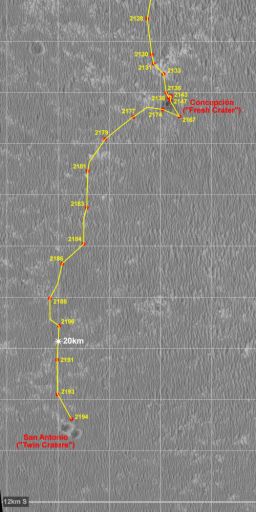 Opportunity recent route
Opportunity recent routeThis route map is a cropped version of the larger one (above) that highlights Opportunity's more recent treks this month. Credit: NASA / JPL-Caltech / Cornell / UA / MSSS / mosaicked by Eduardo Tesheiner
Virtually all of the rovers’ records have served to fuel the magic on the mission, but this one does give one cause for pause. “The engineers designed these things for a kilometer of odometry,” Callas marveled. “20 K is just a huge number for us,” added Squyres, who had the thrill of being the Science Operations Working Group (SOWG) chair that sol, even though he has been on and off rover-duty heading up NASA’s Decadal Survey and at the agency’s headquarters in meetings for much of the month.
That series of four drives totaled more than 260 meters (853 feet) of progress, pushing Opportunity’s odometer to 20,043.30 meters. “We've been banging out steady 67, 70-meters-a-sol kind of drives in March and just covering lots of ground,” said Squyres. “The power numbers are real low on the rover this time of year so we interspersed recharge sols in amongst the drive sols.”
On Sol 2192 (March 25, 2010), Opportunity stopped to rest and recharge her batteries. “It's like taking a trip,” said Callas. “You do a lot of driving and you need to stop and fill the gas tank and that's what they're doing.”
Throughout all the drives this month, most of which have been backwards drives, Opportunity’s right front wheel remained “well-behaved,” Callas informed. This is, of course, good news because the rover has a long way to go to get to Endeavour, which is still 12 kilometers (7 miles) away by the route charted. “And we want a healthy rover when we get to Endeavour,” said Squyres.
Recharged, Opportunity took off again last weekend, driving 55 meters on the first sol of the 3-sol weekend plan, stopping at the first of a pair of craters, dubbed San Antonio West, Golombek reported earlier today. "At the end of that drive it took a Navcam panorama of the crater," he said.
On the third sol of last weekend's plan, Sol 2197 (March 29, 2010), Opportunity took Pancam color pictures of San Antonio West, then drove about 30 meters (98.4 feet) to San Antonio East, where it snapped NavCam images of the crater at the end of the drive. Yesterday, Opportunity took a recharge sol and acquired Pancam pictures of San Anotonio East. "Today [Sol 2199 (March 31, 2010)] Opportunity will resume her drive to Endeavour along the pink path," Golombek said.
As March turns to April, Opportunity is producing around 258 watt-hours under hazy skies, measuring a tau of 0.418. The rover’s power levels fluctuated, bouncing up and down, as usual. “There's always a little uncertainty each day as we do that power estimate and there could always be other effects – clouds and variability in atmospheric opacity and all that contributes,” noted Callas. But the RPs have no additional concerns about this rover since last month and Opportunity should be able to cruise seamlessly, albeit a little bit slower, as it roves toward the depth of this Martian winter.
“Unless something wonderful pops up,” said Squyres, “we're going to just keep motoring.”
 Approaching the San Antonio Craters
Approaching the San Antonio CratersOpportunity took a series of Pancam images on its Sol 2194 (Mar. 27, 2010) of the twin San Antonio craters, which MER artist-poet and aficiando Stuart Atkinson then put into a mosaic and colorzied. The rocky area to the right forms the southern rim of San Antonio West. See more at Atkinson's RoadtoEndeavour: http://roadtoendeavour.wordpress.com/
Credit: NASA / JPL-Caltech / Cornell / colorization by Stuart Atkinson
The Time is Now.
As a Planetary Defender, you’re part of our mission to decrease the risk of Earth being hit by an asteroid or comet.
Donate Today

 Explore Worlds
Explore Worlds Find Life
Find Life Defend Earth
Defend Earth


